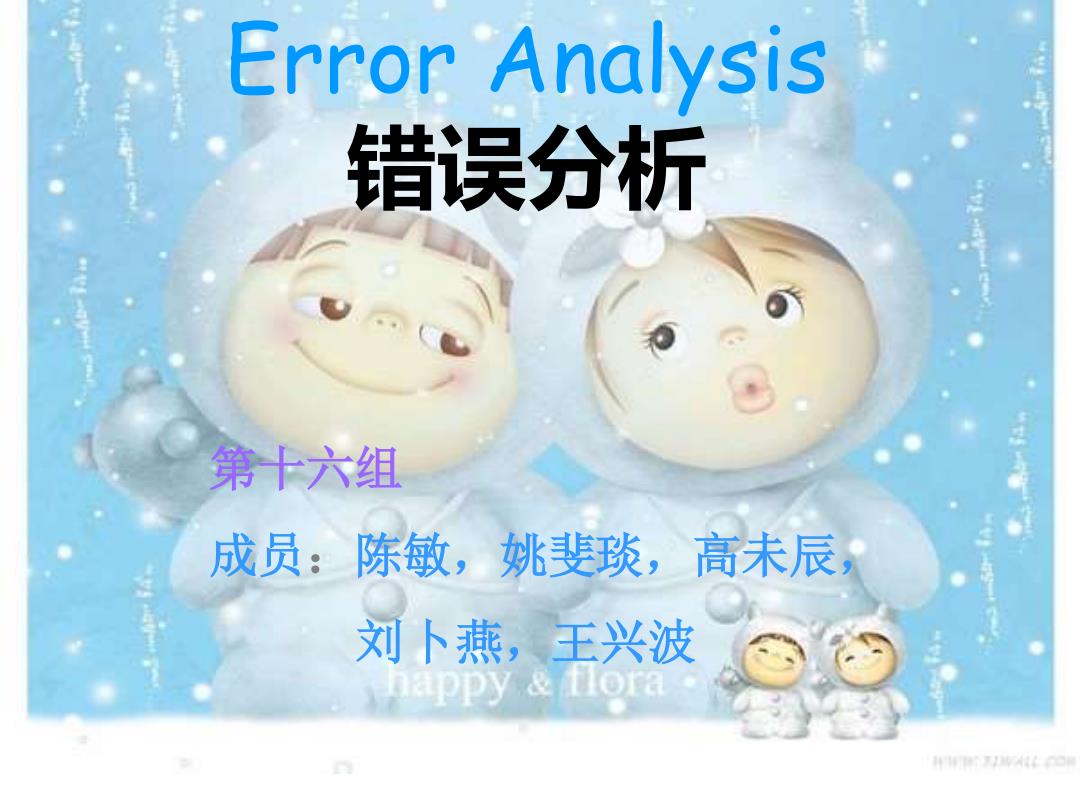
Error Analysis 错误分析 第十六组 成员:陈敏,姚斐琰,高未辰, 刘卜燕,王兴波 happy flora 件A40
Error Analysis 错误分析 第十六组 成员:陈敏,姚斐琰,高未辰, 刘卜燕,王兴波
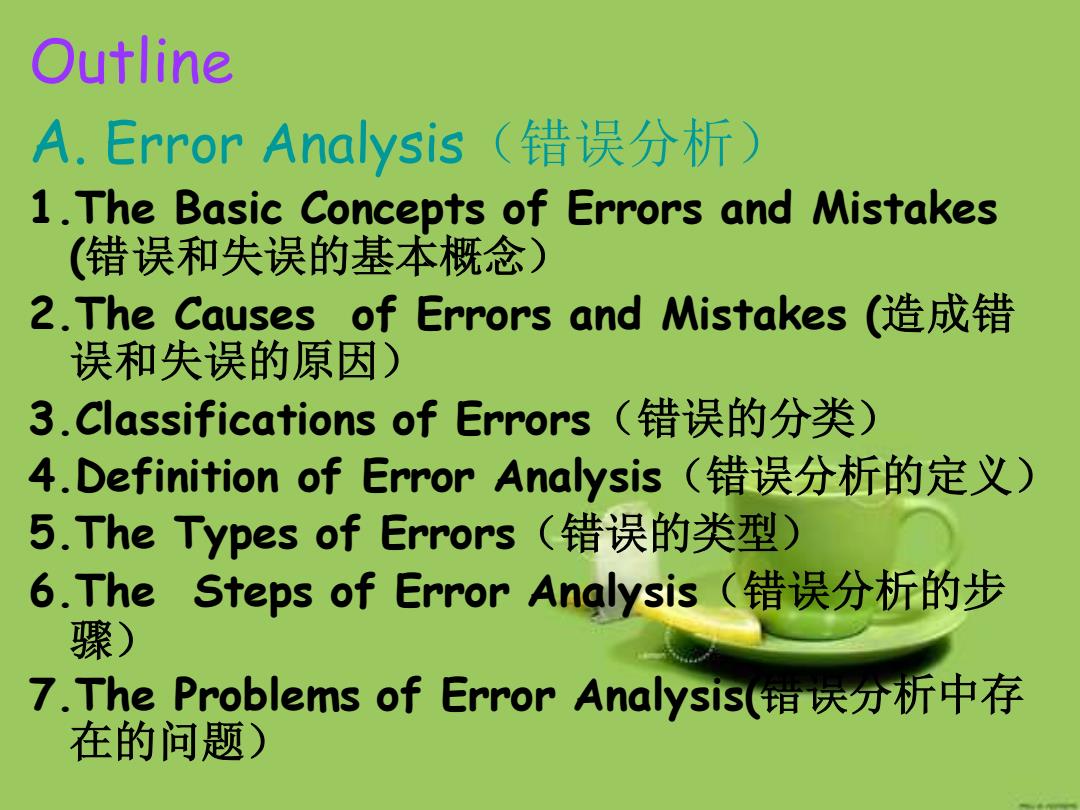
Outline A.Error Analysis(错误分析) 1.The Basic Concepts of Errors and Mistakes (错误和失误的基本概念) 2.The Causes of Errors and Mistakes(造成错 误和失误的原因) 3.Classifications of Errors(错误的分类) 4.Definition of Error Analysis(错误分析的定义) 5.The Types of Errors(错误的类型) 6.The S Steps of Error Analysis(错误分析的步 骤) 7.The Problems of Error Analysis(阳天分析中存 在的问题)
Outline A. Error Analysis(错误分析) 1.The Basic Concepts of Errors and Mistakes (错误和失误的基本概念) 2.The Causes of Errors and Mistakes (造成错 误和失误的原因) 3.Classifications of Errors(错误的分类) 4.Definition of Error Analysis(错误分析的定义) 5.The Types of Errors(错误的类型) 6.The Steps of Error Analysis(错误分析的步 骤) 7.The Problems of Error Analysis(错误分析中存 在的问题)
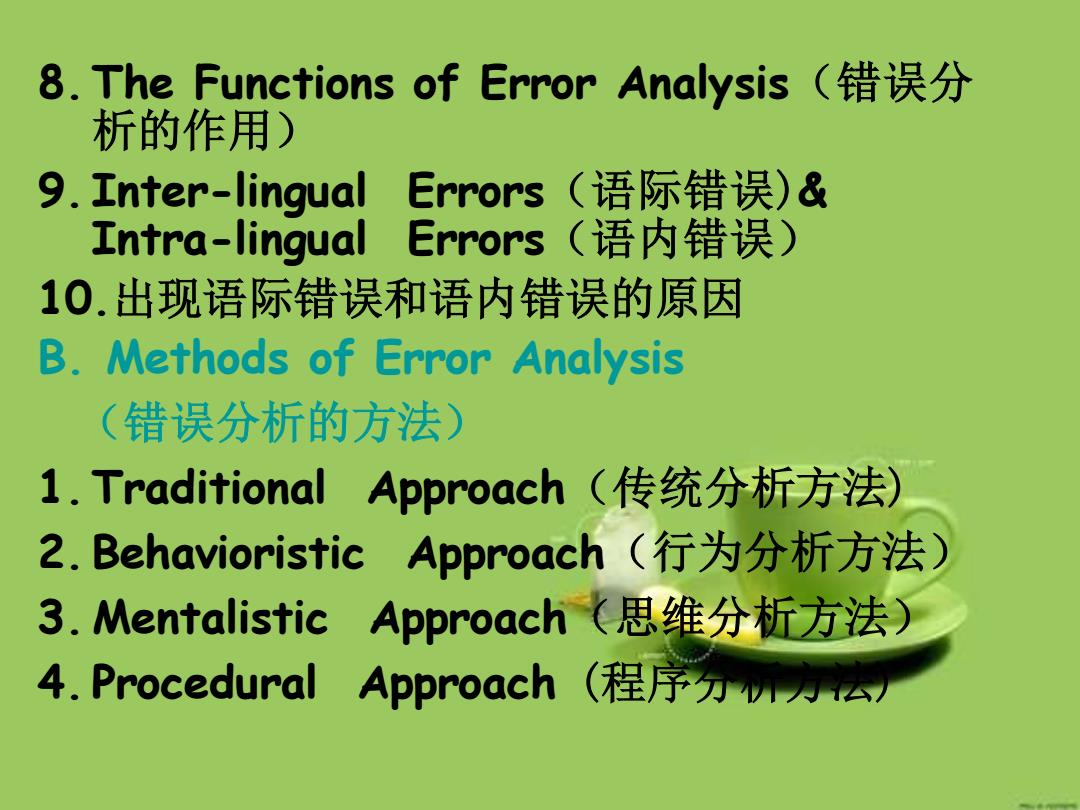
8.The Functions of Error Analysis(错误分 析的作用) 9.Inter-lingual Errors(语际错误)& Intra-lingual Errors(语内错误) 10.出现语际错误和语内错误的原因 B.Methods of Error Analysis (错误分析的方法) 1.Traditional Approach(传统分析方法) 2.Behavioristic Approach(行为分析方法) 3.Mentalistic Approach(思维分析方法) 4.Procedural Approach(程序分m为法
8.The Functions of Error Analysis(错误分 析的作用) 9. Inter-lingual Errors(语际错误)& Intra-lingual Errors(语内错误) 10.出现语际错误和语内错误的原因 B. Methods of Error Analysis (错误分析的方法) 1.Traditional Approach(传统分析方法) 2. Behavioristic Approach(行为分析方法) 3. Mentalistic Approach(思维分析方法) 4. Procedural Approach (程序分析方法)

1.Some Basic Concepts(基本概念) Errors(错误) 1. grammatically incorrect 2.grammatical misuse 3.systematic and regular deviations from correct form of language. E.g.He like reading.She smiling istakes(失误) 1.grammatically correct but improper in the communicative context. 2.Pragmatic misuse 3.not systematic,not the real reflection of the speaker's linguistic competence E.g:1.庞大宏大硕大伟大-领袖毛主席
1.Some Basic Concepts(基本概念) • Errors (错误) 1. grammatically incorrect 2. grammatical misuse 3. systematic and regular deviations from correct form of language. E.g. : He like reading. / She smiling. • Mistakes(失误) 1. grammatically correct but improper in the communicative context. 2. Pragmatic misuse 3. not systematic, not the real reflection of the speaker’s linguistic competence E.g.:1.庞大/宏大/硕大/伟大----领袖毛主席
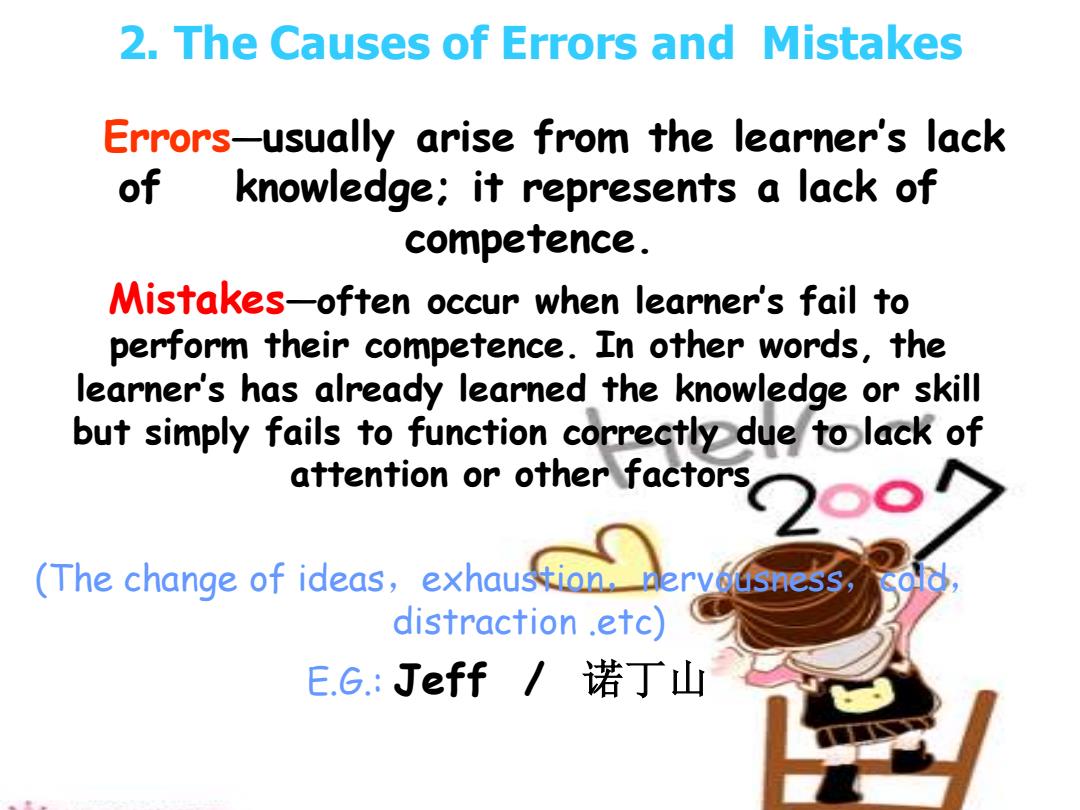
2.The Causes of Errors and Mistakes Errors-usually arise from the learner's lack of knowledge;it represents a lack of competence. Mistakes-often occur when learner's fail to perform their competence.In other words,the learner's has already learned the knowledge or skill but simply fails to function correctly due to lack of attention or other factors (The change of ideas,exhaustion.nerveusacss,cold, distraction .etc) E.G.:Jeff/诺丁山
2. The Causes of Errors and Mistakes Errors—usually arise from the learner’s lack of knowledge; it represents a lack of competence. Mistakes—often occur when learner’s fail to perform their competence. In other words, the learner’s has already learned the knowledge or skill but simply fails to function correctly due to lack of attention or other factors. (The change of ideas,exhaustion,nervousness,cold, distraction .etc) E.G.: Jeff / 诺丁山

3.Classifications of Errors (错误的分类) Global Errors(系统错误)--refer to those that affect the meaning of the whole sentence relations between sentences,and thus can interfere with communication. E.g.Global:We do not take this bus we late for school. Local Errons(局部错误)--refer to those that do not affect the meaning of the whole sentence significantly. E.g.Much people use English language
3. Classifications of Errors (错误的分类) Global Errors (系统错误)----refer to those that affect the meaning of the whole sentence relations between sentences, and thus can interfere with communication. E.g. Global: We do not take this bus we late for school. Local Errors (局部错误)----refer to those that do not affect the meaning of the whole sentence significantly. • E.g. Much people use English language

4.Definition of Error Analysis (错误分析的定义) Error analysis is the process that analysis the occurrence,nature,reasons and effects of an underachieved language usage. 错误分析就是研究不成功语言的出现、性质、原因和后果 的过程。 Error analysis involves,first independently or ob jectively,describing the learner's inter-language (That's to say,their version of the target language and the target language itself).then a comparison of the two is followed to locate mismatch. 错误分析首先要独立,客观地描写学习者的中介语(即学 习者对目标语的理解和目标语本身),然后对第二者进行 比较以找出不匹配之处
4. Definition of Error Analysis (错误分析的定义) • Error analysis is the process that analysis the occurrence, nature, reasons and effects of an underachieved language usage. • 错误分析就是研究不成功语言的出现、性质、原因和后果 的过程。 • Error analysis involves, first independently or objectively, describing the learner’s inter-language (That’s to say, their version of the target language and the target language itself), then a comparison of the two is followed to locate mismatch. • 错误分析首先要独立,客观地描写学习者的中介语(即学 习者对目标语的理解和目标语本身),然后对第二者进行 比较以找出不匹配之处
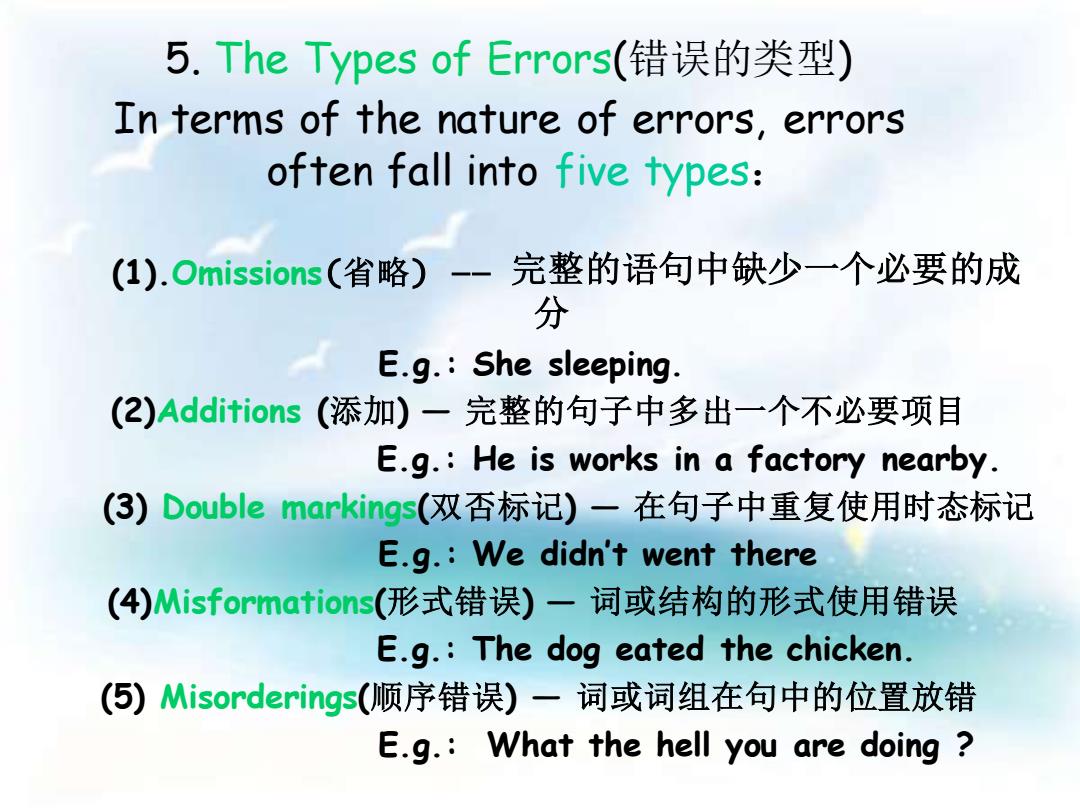
5.The下ypes of Errors(错误的类型) In terms of the nature of errors,errors often fall into five types: (1).Omissions(省略)-- 完整的语句中缺少一个必要的成 分 E.g.:She sleeping. (2)Additions(添加)一完整的句子中多出一个不必要项目 E.g.:He is works in a factory nearby. (3)Double markings(双否标记)一在句子中重复使用时态标记 E.g.:We didn't went there (4)Misformations((形式错误)一词或结构的形式使用错误 E.g.:The dog eated the chicken. (⑤)Misorderings(顺序错误)一词或词组在句中的位置放错 E.g.:What the hell you are doing
5. The Types of Errors(错误的类型) In terms of the nature of errors, errors often fall into five types: (1).Omissions(省略) —— 完整的语句中缺少一个必要的成 分 E.g.: She sleeping. (2)Additions (添加) — 完整的句子中多出一个不必要项目 E.g.: He is works in a factory nearby. (3) Double markings(双否标记) — 在句子中重复使用时态标记 E.g.: We didn’t went there (4)Misformations(形式错误) — 词或结构的形式使用错误 E.g.: The dog eated the chicken. (5) Misorderings(顺序错误) — 词或词组在句中的位置放错 E.g.: What the hell you are doing ?
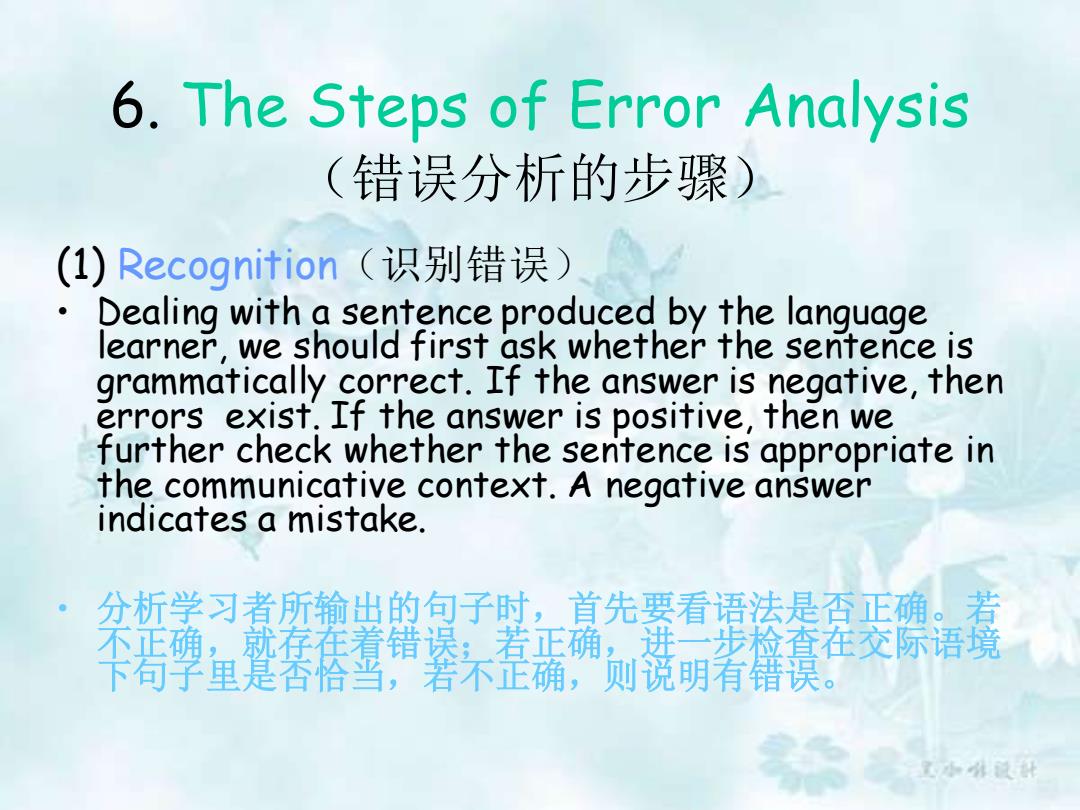
6.The Steps of Error Analysis (错误分析的步骤) (1)Recognition(识别错误) Dealing with a sentence produced by the language learner,we should first ask whether the sentence is grammatically correct.If the answer is negative,then errors exist.If the answer is positive,then we further check whether the sentence is appropriate in the communicative context.A negative answer indicates a mistake. 分析学习者所输出的句子时,首先要看语法是否正确。若 不正确,就存在着错误;若正确,进二步检查在交际语境 下句字里是香恰当,若不正确,则说明有错误
6. The Steps of Error Analysis (错误分析的步骤) (1) Recognition(识别错误) • Dealing with a sentence produced by the language learner, we should first ask whether the sentence is grammatically correct. If the answer is negative, then errors exist. If the answer is positive, then we further check whether the sentence is appropriate in the communicative context. A negative answer indicates a mistake. • 分析学习者所输出的句子时,首先要看语法是否正确。若 不正确,就存在着错误;若正确,进一步检查在交际语境 下句子里是否恰当,若不正确,则说明有错误

(2)Description(描述错误 ) If the erroneous sentence is intelligible,we compare it with the correct sentence produced by a negative speaker and list the errors and mistakes. If the meaning of the sentence is not clear,we may refer to the learner's negative language to find out what he means and carry out a contrastive analysis. Taking into consideration the use of language in social contexts,we can describe mistakes as well as errors. 如果错误的句子可以理解,把它与本族语者所输出的句 子相比较,找出错误和失误。如果句子的意思的意思不 暮对配琴擦据享對者的每语来狡蔸仙所复表送的這电
(2) Description(描述错误) • If the erroneous sentence is intelligible, we compare it with the correct sentence produced by a negative speaker and list the errors and mistakes. If the meaning of the sentence is not clear, we may refer to the learner’s negative language to find out what he means and carry out a contrastive analysis. Taking into consideration the use of language in social contexts, we can describe mistakes as well as errors. • 如果错误的句子可以理解,把它与本族语者所输出的句 子相比较,找出错误和失误。如果句子的意思的意思不 清楚,可以根据学习者的母语来发现他所要表达的意思, 进行对比分析